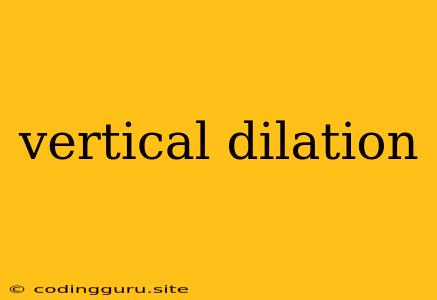Understanding Vertical Dilation: Reshaping Functions
Vertical dilation, a fundamental concept in mathematics, especially within the realm of function transformations, describes the process of stretching or compressing a function vertically. This transformation, often denoted by a scaling factor, directly impacts the y-values of the function, resulting in a visually altered graph.
What is Vertical Dilation?
Imagine you have a function, say f(x), represented by a curve on a graph. Now, imagine pulling or pushing this curve up or down, while keeping its general shape intact. This action is known as vertical dilation.
Think of it like zooming in or out on a picture, focusing on the vertical dimension.
How does Vertical Dilation Work?
Vertical dilation is achieved by multiplying the original function f(x) by a constant factor, commonly denoted as "a." This factor determines the extent of stretching or compressing.
- If |a| > 1: The function is stretched vertically. A larger value of a indicates a greater stretch.
- If 0 < |a| < 1: The function is compressed vertically. A smaller value of a indicates a greater compression.
- If a < 0: The function is reflected across the x-axis. This combines dilation with a vertical reflection.
For example: If you have the function *f(x) = x², and you multiply it by 2 to obtain g(x) = 2x², then g(x) will be vertically stretched by a factor of 2 compared to f(x).
Understanding the Impact of Vertical Dilation
Vertical dilation plays a critical role in shaping the behavior of functions. It can:
- Change the steepness of the curve: Dilation can make a graph steeper or flatter.
- Alter the intercepts: The y-intercept will be multiplied by the dilation factor, while the x-intercept may or may not be affected depending on the function's behavior.
- Affect the range: The range of the function, which represents the set of possible y-values, will be scaled by the dilation factor.
Example: Applying Vertical Dilation
Consider the function f(x) = x³ and its vertical dilation by a factor of 3.
- Original Function: f(x) = x³
- Dilated Function: g(x) = 3x³
Now, let's examine the effects:
- Stretching: The graph of g(x) is stretched vertically by a factor of 3 compared to f(x).
- Intercepts: The y-intercept of f(x) is 0, and the y-intercept of g(x) is also 0. However, the x-intercepts remain the same, at x = 0.
- Range: The range of f(x) is all real numbers, and the range of g(x) is also all real numbers. However, the y-values of g(x) will be 3 times greater than the corresponding y-values of f(x).
Practical Applications of Vertical Dilation
Vertical dilation finds applications in various fields, including:
- Engineering: In structural engineering, vertical dilation is used to analyze the behavior of beams and columns under load.
- Physics: In physics, vertical dilation is used to describe the stretching or compressing of springs and other elastic materials.
- Economics: In economics, vertical dilation can be used to model changes in supply and demand.
Conclusion
Vertical dilation is a fundamental transformation that allows you to manipulate the vertical aspect of a function's graph. By understanding its effects, you gain the ability to reshape functions, study their behavior, and analyze them in diverse contexts. Whether it's scaling the steepness of a curve, altering intercepts, or changing the range, vertical dilation provides a powerful tool for exploring and interpreting functions in various disciplines.
